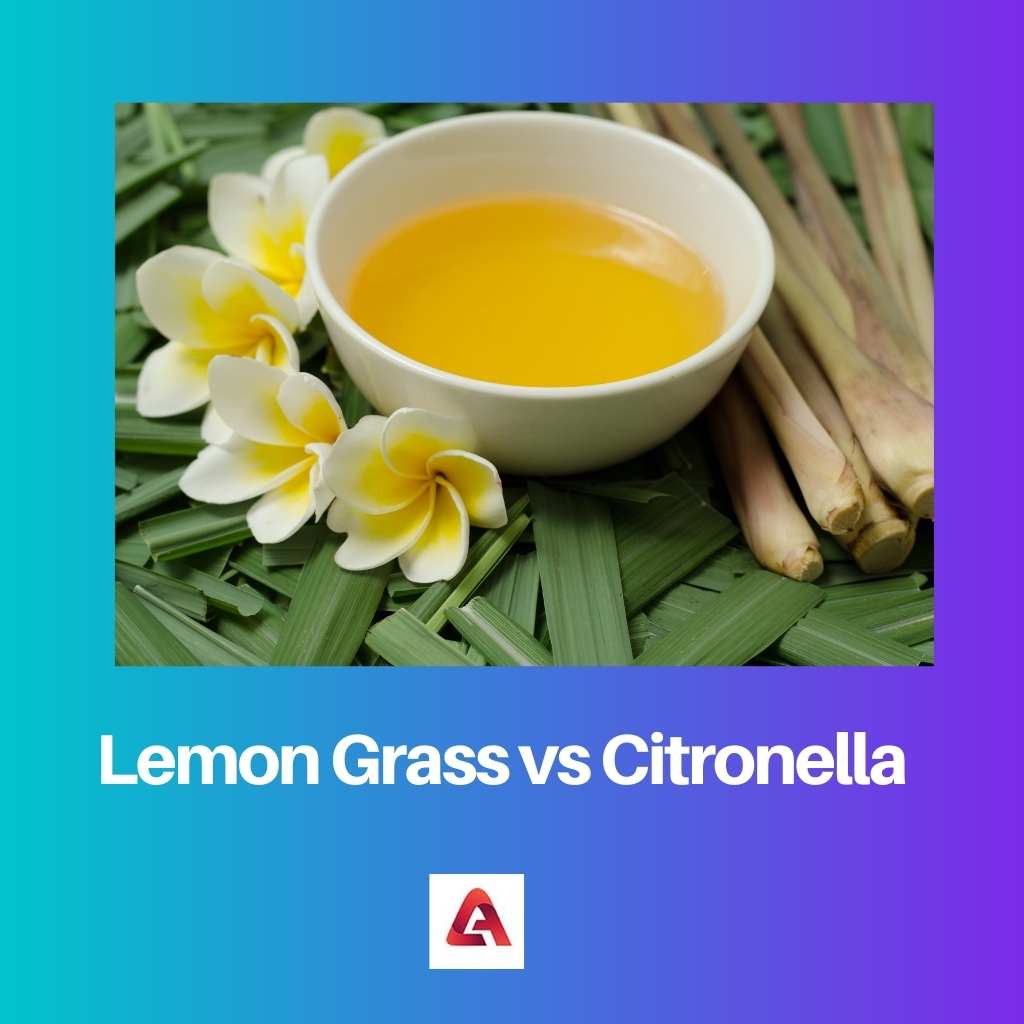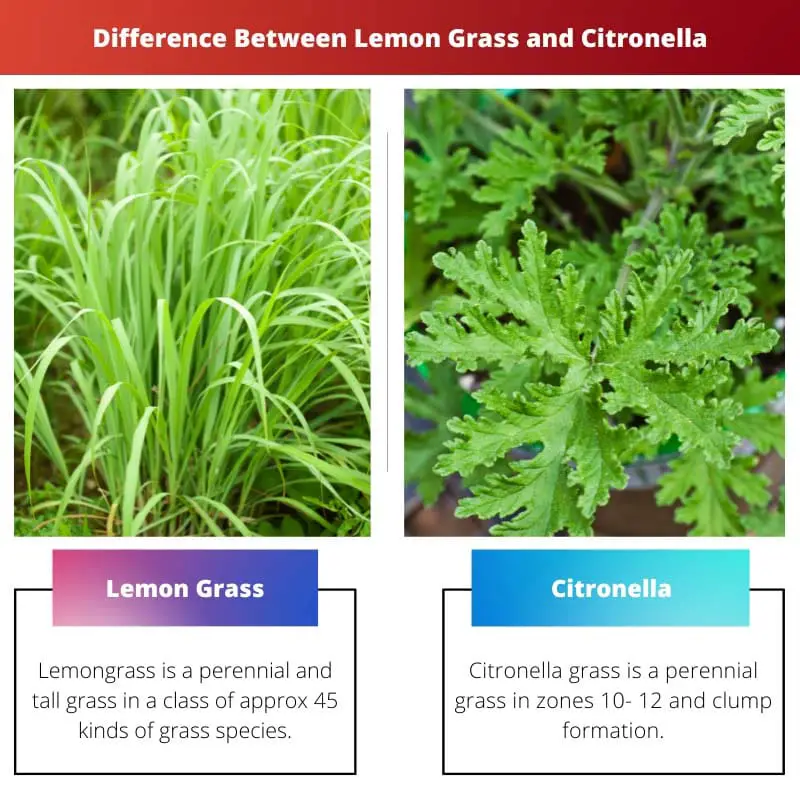Globally every year approx more than 600 million people acquire illnesses related to mosquito-borne namely the zika virus, malaria, chikungunya virus, dengue, and West Nile virus.
Since currently there is no known effective vaccine shield for these diseases. The usage of repellents mainly plant-based provides a suitable alternative for shielding against mosquito bites.
Knowing the mosquitoes’ dangers, plant-based repellents provide a ray of hope. Mainly in reduction of exposure’s risk and acquiring disease mosquito-borne.
In this article, the chief aim is on differentiating two used repellent plants namely, lemongrass and citronella.
Key Takeaways
- Lemongrass, or Cymbopogon citratus, is a herb used for culinary purposes and as a natural remedy, while citronella, or Cymbopogon nardus, is primarily used as an insect repellent.
- Lemongrass has a fresh, lemony flavor and scent, while citronella has a strong, grassy aroma.
- Both plants belong to the Cymbopogon genus, but lemongrass is more versatile due to its various culinary and medicinal uses.
Lemon Grass vs Citronella
Lemongrass, also known as Cymbopogon citratus, is a tropical plant native to Southeast Asia and is widely used in cooking and herbal medicine. The plant is characterized by long, slender leaves. Citronella is a type of grass belonging to the Cymbopogon genus, with two common species: Cymbopogon nardus and Cymbopogon winterianus. Citronella has long, thin leaves.

Lemongrass is a perennial and tall grass in a class of approx 45 kinds of grass species.
The highest producer of lemongrass across the world is India where it is cultivated along with Western ghat’s mountain range and besides the Sikkim and Arunanchal Pradesh’s foothills in the Himalayan mountains.
The summer is the lemongrass’s growth greatest time.
Citronella grass is a perennial grass in zones 10- 12 and clump formation but many northern climate gardeners grow it as an annual. Oftentimes, citronella plants that are sold are not true citronella plants.
They are instead other plants having a citronella-like scent. It is also used for lice treatment and other parasites such as intestinal worms.
Comparison Table
| Parameters of comparison | Lemon Grass | Citronella |
|---|---|---|
| Botanical name | Cymbopogon | Cymbopogon Nardus |
| Stem color | Red or magenta | Green |
| Soil | Medium fertile soil with a pH of 6.5 to 7.0 | Sandy loamy soil with a pH of 6.6 to 8.0 |
| Rainfall | 250- 330cm rainfall per annum | 200- 250cm rainfall per annum |
| Size | 3 to 5 feet tall and wide up to 2 feet | Tall up to 6 feet and 6 feet wide |
What is Lemon Grass?
Lemongrass is a genus of Australian, tropical island, African, and Asian plants in the grass family. Several species Cymbopogon citratus are cultivated as medicinal and culinary herbs due to their scent just like lemon.
It is used for citronella oil production which is used in a range of products.
The chief chemical citronella, citronellol, and geraniol’s constituents are antiseptics, hence in household soaps and disinfectants, they are used.
Besides oil production, it is used for purposes of culinary as a flavoring. From the two Greek words, namely, kymbe and pogon the name Cymbopogon is derived.
It means in most species the projection of hairy spikelets from spathes of boat-shaped.
West Indian lemongrass is native to southeast Asia’s maritime, while East Indian lemongrass also called Malabar grass or Cochin grass is native to Thailand, Cambodia, Burma, Vietnam, and many more.
In Hoodoo, lemongrass is the chief ingredient of van oil which is one of the most famous oils used in conjure. In beekeeping, it imitates the pheromone emitted by a Nasonov gland of honeybee used to attract bees to swarm or to a hive.

What is Citronella?
Citronella is a fast-growing and tall grass that releases a lemony signature scent when crushed, which other insects like mosquitos dislike.
Citronella grass also acts as stunning decorative grass. It boasts grass-lance-shared blades and also from summer to fall it produces spiked and light brown flowers.
Citronella is hardy to 32 F, which means only in warm climates it is perennial.
It does not matter what is the location and whether you plant in a pot or the ground, this Citronella needs sunshine and water. If planting is done outside, then it is vital to rid seed heads after flowering.
A nitrogen high fertilizer is suitable for citronella grass. Once a year, the fertilizer is needed to feed in the spring to encourage healthy growth. For growing healthy citronella grass well-draining soil is key.
A well-draining soil will help shield problems like root rot.
Citronella grass fails to handle cold temperatures for time’s long periods. If someone likes to keep citronella alive but lives in a cold, long winter area then keep citronella in a pot, and before the first frost bring it indoors.
As for humidity, citronella loves moisture and thrives mainly in humid climates.

Main Differences Between Lemon Grass and Citronella
- When it comes to caring requirements, lemongrass should have barely moist soil as overwinter it grows very slowly. Another option is to store lemongrass’s pot, cut down, in a dark, cool place, and to keep roots alive water just a few times. Meanwhile, plenty of moisture is needed in citronella but it also dislikes wet feet. Over winter only water when it looks or feels dry.
- In terms of cons, lemongrass might cause skin irritation rash, and have toxic side effects like lung problems after inhaling lemongrass. On the contrary, allergic reactions around the skin or in the eyes might experience is cons of citronella.
- Lemongrass is used in beverages and food as a flavoring. In manufacturing, it is used as a fragrance in cosmetics, soaps, and deodorants. On the other hand, citronella can be used as antimicrobial, antispasmodic, anti-antifungal, and anti-inflammatory.
- Most of the lemongrass species are native to Australia, Southeast Asia, and South Asia. On the other hand, citronella is native to Asia’s tropical areas. Citronella is commercially grown in Sri Lanka, Burma, Indonesia, India, and Java.
- The benefit of lemongrass is that in some yeast and bacterial growth can be prevented. It also relieves swelling and pain, improves sugar levels, and many more. In contrast, citronella benefits in relieving tensions, migraines, and even depression. It can also aid in muscle relaxation and reduce fever.

References
- https://www.sciencedirect.com/science/article/pii/B9781845690175500245
- https://www.sciencedirect.com/science/article/pii/S0378517308008697




